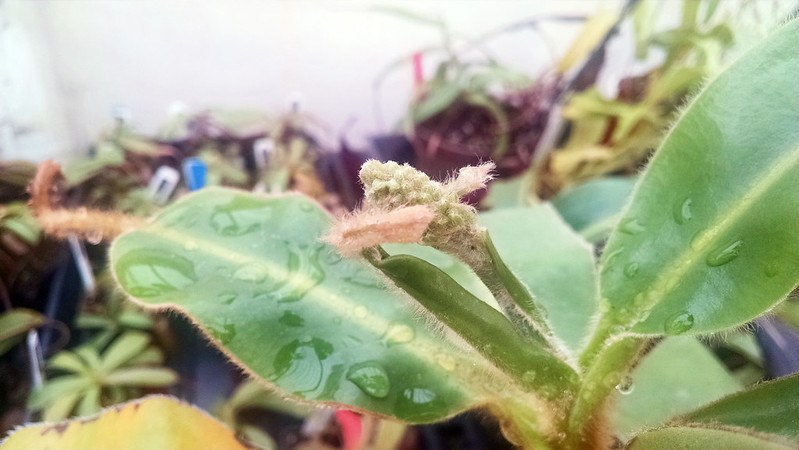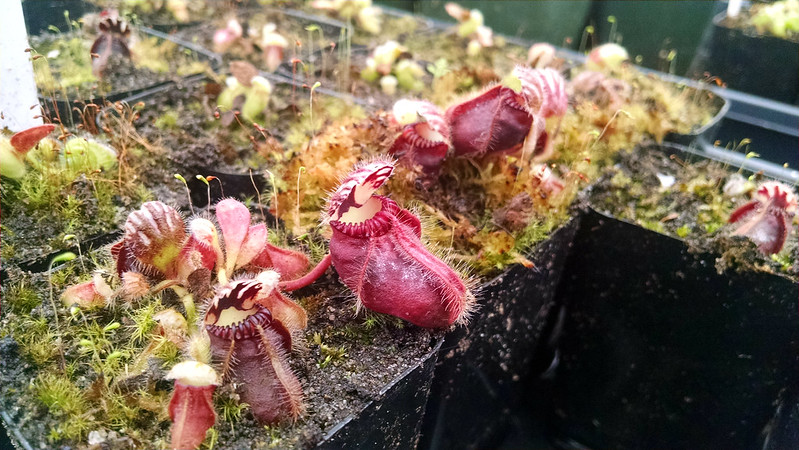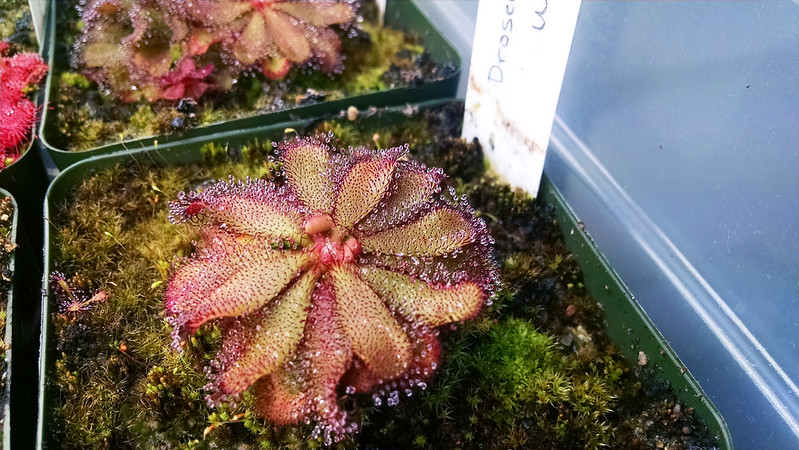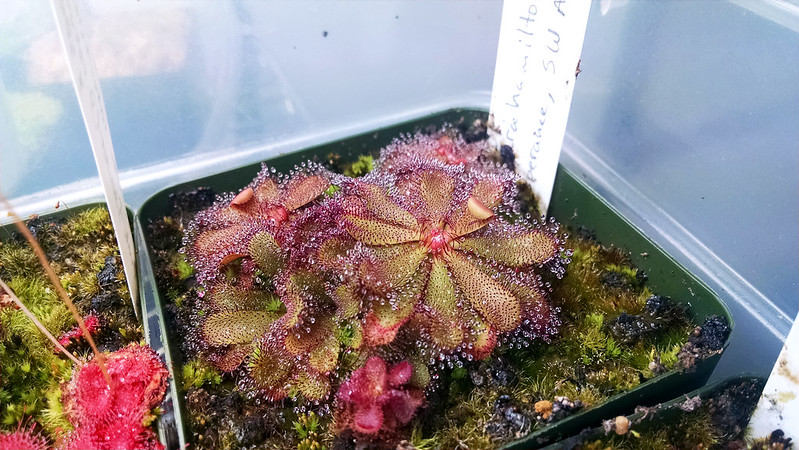Yesterday I decided to go hang out in San Francisco with my friend Josh, owner of
Predatory Plants. I thought I'd head home early to beat the commute traffic, but unfortunately the commute traffic got started around 1 pm, so I ended up sitting around his greenhouse checking out all the weird stuff he's got around (and also catching up on all the carnivorous plant gossip).
This
Nepenthes glandulifera flower stalk looks like a certain other prized inflorescence.
 |
| Like a teddy bear. |
This plant is so fuzzy it's ridiculous.
The clump of
Drosera omissa ×
pulchella is just about to attain sentience.
 |
| Be careful of pygmy hybrids. |
Meanwhile the
Drosera scorpioides are looking quite Dr. Seuss-like.
 |
| They look so fragile. |
I correctly guessed that these plants are three years old. It's fun having extremely niche expertise.
Josh discovered something funny about his pots of
Pinguicula planifolia.
 |
| They're attractive plants, just baffling. |
See that hole in the pot? It's hollow underneath. I guess in the two-plus years these have been growing here the bottom layer of soil has gradually been washed away, while the top is held together by the moss. Josh says he's afraid to mess with it now, since the plants seem to be fine.
I had to stop to admire this fine patch of
Drosera filiformis Florida red.
 |
| I love this plant. Great color. |
These are around two years old. Really lovely plants! I wish mine would get a move on and start filling out.
Also, Josh recently got into growing
Cephalotus, and the results are looking pretty good!
 |
| So squat and hairy! |
Everybody loves Cephs. If there was more of a consensus on how to grow them (and an easier way to produce them) I'm sure they'd become one of the most popular plants in cultivation.
Towards the end of the day Josh was planting up some
Drosera hamiltonii to a larger tray. For every plant he repotted he got a root cutting to start a new one. It's a very efficient system.
 |
| Those are some good-looking roots. |
Seeing all those
D. hamiltonii made me want to check in on my own when I got home. They're looking great!
 |
| Dew like crazy. |
 |
| I love seeing the new leaves unfurling. |
This is definitely one of those species where the less you mess with them the better they look. I think I spotted a root or two creeping into the tray though. I should get some propagation going. Look at those plants!









Wow! Your D. hamiltonii look amazing! I had a couple, but, sadly, they passed. Once I get Cephs right, I think I'll pick up another one and pot it with the Cephs. I saw a little Ceph set-up once with a bunch of natives and it looked really neat.
ReplyDeleteThose Dews Josh has are so concentrated! That's really incredible!
I would love to know more about how you care for D. hamiltonii. I just recently obtained one about a month ago. I hear they can be quite picky.
ReplyDeleteHonestly, D. hamiltonii isn't all that different from my other sundews, with the exception that they are a lot slower to bounce back from any disruption. When I've fed them they will eat happily, but they lose all their dew for weeks afterwards. Also, there have been a few instances when they just start looking terrible for a while for no reason, and then get better. Just be a bit patient with them and it should be fine.
Deletecartoon design just 5$ and ORDER now fiverr and order now
ReplyDeleteIn the event that you need a fascinating shoreline get-away, make certain to pick a resort that has its own private shoreline that you can basically exit onto whenever you wish.la quinta inn kansas city
ReplyDeleteFrost causes the water in the plant cells to freeze which damages the cell wall and as a result the inside structure of the plant is damaged. When the ground is frozen, roots cannot take up any water to feed the plant and as a result dies. large indoor plants
ReplyDeleteIn nowadays of furious lives and occupied calendars our recreation time has happened to considerably more noteworthy significance as the chances to loosen up appear to be so few. Moreover, with the extensive variety of choices accessible to the explorer filtering through them all occasionally detracts from the pleasure in your vacation.hotels in hays ks
ReplyDeleteThe blog has a to an extraordinary degree restrain focus that opens up, shockingly into broad assortment of concerns.
ReplyDeleteLiving wall
It is a great website.. The Design looks very good.. Keep working like that!. プライバシー を 守る
ReplyDeleteSuch a strikingly basic article.I basically wish to offer a creature proceed for the standard data you have perfect here on this post. http://funnypickuplines.info
ReplyDeleteAt the point when an early ice happens, not just have you not readied your garden for chilly climate and ice, the plants themselves might not have set themselves up either and a surprising ice can happen when they are not prepared.Autoflowering Seeds
ReplyDeleteThese kinds of plants are pruned into cylinders called 'local cylinders' which are tall, yet at the same time just 70mm wide.https://www.farmpally.com/kenaf-plant/
ReplyDelete